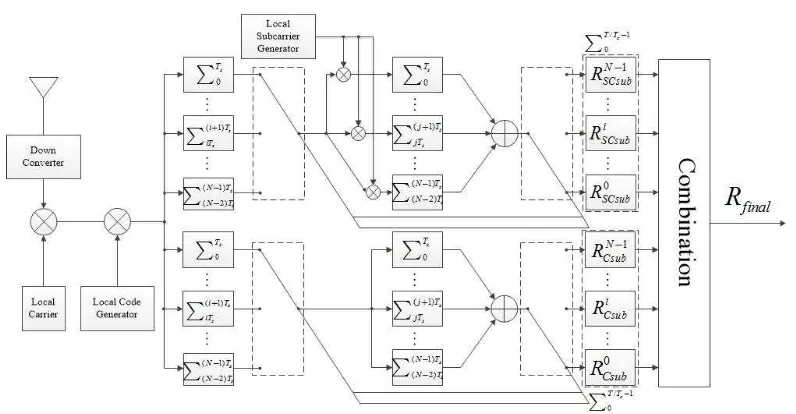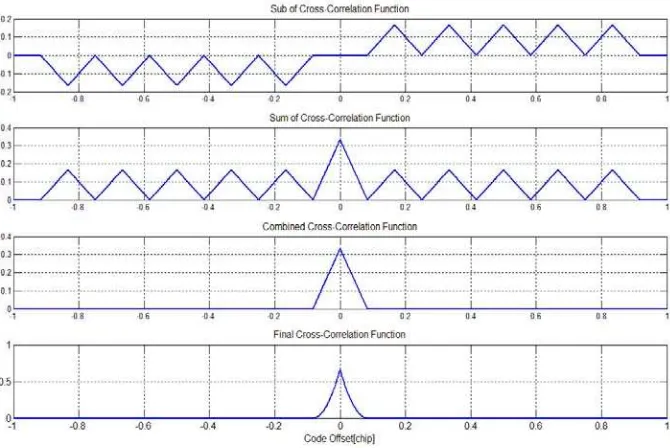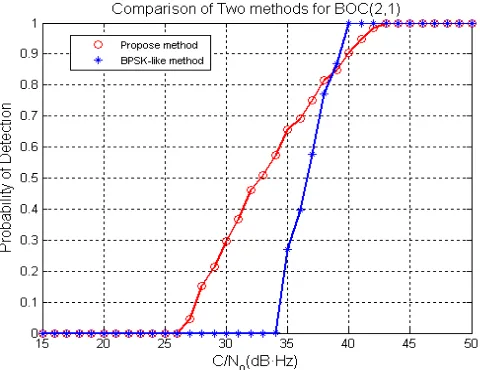DOI: 10.12928/TELKOMNIKA.v13i2.1469 502
Unambiguous Sine-Phased BOC (kn,n) Signal
Acquisition Based on Combined Correlation Functions
Deng Zhongliang1, Xi Yue*2, Yin Lu3
Beijing University of Posts and Telecommunications, China
*Corresponding author, e-mail: dengzhl@bupt.edu.cn1, xiyue0430@gmail.com2, inlu_mail@163.com 3
Abstract
Galileo and GPS have been developing their new signals in recent years. Multiplexed Binary Offset Carrier (MBOC) is the final implementation of Galileo E1 and GPS L1C, which is the multiplexing of BOC (1,1) and BOC (6,1). Therefore, it is helpful to satisfy the demand that the new signals must be compatible with GPS BPSK signal. BOC (kn,n) modulation will provide better track performance and higher positioning accuracy. However, the main drawback of the BOC modulated signal is that its autocorrelation has multiple side peaks around the main peak. This paper will focus on a family of signals: sine-phased BOC (kn,n). We are trying to explore a new method to cancel the side peaks of BOC (kn,n) autocorrelation, making use of two kinds of correlation functions. One is the correlation of the incoming signal and the sine-phased BOC (kn,n) modulated spreading code(PRN code multiplied by subcarrier), and the other is the correlation of the incoming signal and the PRN code only. Two kinds of correlation function are separated into several sub-correlations. Sub-correlations have less side peaks which are in different code delays. Corresponding parts of two sub-correlations will be combined to cancel the side peaks separately, and finally the new function without side peaks will be acquired after several correlations added together. Simulation results will be given. It is shown that the proposed method is contributed to the side peaks cancellation for unambiguous sine-phased BOC (kn, n) signal acquisition.
Keywords: Sine-Phased BOC (kn,n) Signal, Unambiguous Acquisition, Combined Correlation Functions
1. Introduction
Galileo and GPS have been developing their new signals in recent years. In the new generation of Global Navigation Satellite Systems (GNSSs), Multiplexed Binary Offset Carrier (MBOC) modulation is recommended for the GPS L1C signal and the Galileo E1 OS signal [1]. The MBOC modulation places a small amount of additional power at high frequencies in order to improve signal tracking performance, which is the multiplexing of BOC (1,1) and BOC (6,1). The Binary Offset Carrier (BOC) modulation can split spectrum into two main lobes shifted from the center frequency by the frequency of the subcarrier. The common notation for BOC-modulated signals in the GNSS field is BOC (fs,fc) wherefsis the frequency of the sub-carrier, and fc represents the spreading code chip rate. Bothfsand fcare usually noted as a multiple of the reference frequency of 1.023 MHz. Therefore, BOC-modulated signals are also noted as BOC (m,n), where m means the ratio of the sub-carrier frequency fs to 1.023 MHz and n represents the ratio of the spreading code rate fc to 1.023 MHz.
With the property of splitting spectrum, BOC modulation can reduce the intra-system interference and improve code delay tracking. Nevertheless, BOC-modulated signal will lead to a main drawback that is the autocorrelation function has multiple side-peaks, which will probably result in possible false acquisition. Several techniques have been proposed in the literature [2],[3].
In this paper, we will focus on the acquisition of the sine-phased BOC(kn,n) signals, where k is the ratio of the sub-carrier frequency fs to the spreading code ratefc. At first, the signal model will be given. Then, two kinds of correlation functions are obtained which are composed of sub-correlations. Side peaks of auto correlation function will be shown. Through combining of different sub-correlations, we will have new correlation without side-peaks. Finally, theoretical results will be given.
2. Signal Model
Sin-phased BOC baseband signal is a special case of (BCS) signal with a representation vector formed by +1’s and -1’s alternating in a particular defined way. The sine-phased BOC(kn,n) baseband signal can be expressed as
2 1
unit rectangular sub-carrier pulse waveform over [0, Ts). The full expression of sine-phased
BOC(kn,n)signal will contain the spreading code and the navigation data, which is
( ) ( ) ( ) ( ) focusing on the ambiguous acquisition of
sin( )
BOC
s t signal, we assume that the navigation data
is always 1, which means that we choose a pilot channel for acquisition and furthermore we also don’t consider the effect of secondary code.
During the process of acquisition, the spreading code or the sub-carrier will be wiped off. Therefore, there are two kinds of autocorrelation function which depends on the local generated signal. One is the correlation of the sine-phased BOC(kn,n) with the spreading code only. The other is the correlation of the sine-phased BOC(kn,n) with the spreading code and sub-carrier both. Without considering the front-end filtering, the normalized BOC correlation function of the sine-phased BOC(kn,n) with the spreading code and sub-carrier both can be expressed as:
/ 1 1 1
is a triangular function, which is the correlation function of two rectangular pulse waveform, and
is the sub-correlation function of the sine-phased BOC(kn,n) with the spreading code and sub-carrier both. We can see that this sub-correlation function RSCsubi ( )t is a combination of triangular functions with different phases. And RSC( )t is the combination of different i ( )
SCsub
R t , which is the reason of the ambiguity problem.
The second kind of correlation function is the correlation function of the sine-phased
BOC(kn,n) with the spreading code only, which can be expressed as (7) in case that the
front-end filtering is not considered.
is the second kind of sub-correlation function, which is also the combination of triangular functions with different phases. However, the factor of triangular functions in two kinds of sub-correlation function is different. Two kinds of sub-correlation functions are shown in Figure 1.
Figure 1. Correlation functions and sub-correlation functions
3. Proposed Method
function is the envelope of the first kind of sub-correlation function, either above zero or below zero. When iis even, the second kind of sub-correlation is above zero and wheniis odd, the second kind of sub-correlation is below zero. Therefore, the second kind of sub-correlation function can be used to make the first kind of sub-correlation function has only side peaks above zero. So we can get sub-correlation function only with side peaks above zero expressed as
( ) ( ) ( 1) ( )
i i i i
SC C
R t = R t + - R t (9)
Wheni=0, the left-most side peak of sub-correlation function is at t=0 and with
iincreased by 2, there will be one more side peak at t <0 and one less side peak at t > 0. Finally, the right-most side peak ofcombined sub-correlation function is at t=0, when i N= . With the increase of i, the side peaks of different combined sub-correlation function move from the right of X-axis to the left and are symmetric about Y-axis, which can be expressed as
1
( ) ( )
i N i
R t = R - - - t (10)
We can just make use of this property to make sure that all of side peaks will be cancelled through combination of them. At first, we combine 0
( )
And then, we can get the final correlation function by combining Rcom( )t with the sum of the combined sub-correlation functions, which can be expressed as
1
4. Receiver Structure
Figure 2 shows the receiver structure of proposed method in this paper. The RF signal is first down-converted to IF signal. Then, the Doppler frequency is wiped off by the Local Code Generator. The output is multiplied by the local PRN code. There will be two channel to go on processing the signal. The aims of the two channel are to form the correlation of the sine-phased BOC(kn,n) with the spreading code and the subcarrier both and the correlation of the sine-phased BOC(kn,n) with the spreading code only. In one channel, the result will be integrated separately after multiplied by N different phases of local subcarrier, which is either ‘-1’ or ‘+‘-1’. All of the integrated result will be summed up and saved as one of RSCsubi . After the
total coherent time T, there will be T T/ c RSCsubi and the sum of them will be the final i SCsub
R .
Finally, we will get N i SCsub
R . In the other channel, the signal is processed almost the same. The only difference between them is that signal in the latter one will not be multiplied by local subcarrier and NofRCsubi will be got. And finally different
i Csub
R and RSCsubi will be combined to form
Figure 2. Receiver structure of the proposed method
It is shown that 2N of correlators works one by one. Only two of them are working at the same time. Therefore, we can make use of all of them to search different code phases at the same time. The architechture is shown as follow.
1
0
1
i i
1
0
1
i i
Figure 3. Time division receiver architechture of proposed method
Therefore, several correlation results can be got after coherent time. In this way, a faster acquisition will be accomplished.
5. Performance Analysis 5.1. Correlation Functions
Figure 4. Correlation functions with k=6
5.2. Detection Probability
The goal of the acquisition process is to detect the presence of the useful signal and give a rough estimate of its main parameters including code delay and Doppler frequency. The theory of traditional acquisition method is widely developed and the expression of the correlator outputs can be expressed as
( , ) ( ) ( ) ( ) ( , ) Doppler frequency, A= Pis the received signal power, Rfinal( )t is the final correlation function,
e
f
V is the difference between the real Doppler frequency and the local Doppler frequency FD,
f is the error on the phase, nI( ,t FD)and nQ( ,t FD) are the in-phase and quadrature correlator
output noises. It is also proved that the noise coming from two channels to generate the sub-correlation function i ( )
SC
R t and i( )
C
R t is independent and each of them is the Gaussian noise with a certain variance [7-9]. Combining them to formulate nI( ,t FD)and nQ( ,t FD) is a
non-linear process, so it is difficult to obtain the mathematical expression of nI( ,t FD)and nQ( ,t FD).
In this paper, we choose Monte Carlo (MC) simulation with 104 runs to show the detection probability.
We assume the following parameters: Tcoh = LTc=1ms, L=1023, the code search step is Ts and false alarm is 10-4. Furthermore, we assume that Doppler frequency is almost zero.
Figure 5. Comparison of two methods for BOC(2,1)
6. Conclusion
In this paper, a method to accomplish the side-peaks cancellation for unambiguous sine-phased BOC(kn,n) signal acquisition. First, we have introduced the signal model of the BOC (kn,n) signal and two kinds of correlation functions composed of several sub-correlation functions. Secondly, the method is proposed to cancel all of the side-peaks in the traditional correlation function and the final correlation function is formulated. Then, the final correlation functions with different k is shown. A time division receiver architechture is proposed also to accomplish a faster acquisition. Finally, detection probability of different BOC (kn,n) signals is compared by the Monte Carlo simulation. The proposed method is clearly observed to remove the side-peaks completely for the sine-phased BOC (kn,n) signal.
References
[1] Samad MF, Lohan ES. MBOC Performance in Unambiguous Acquisition. CDROM Proceedings of
ENC-GNSS. 2009: 3-6.
[2] Martin N, Leblond V, Guillotel G, et al. BOC (x, y) signal acquisition techniques and performances. Proceedings of the 16th International Technical Meeting of the Satellite Division of The Institute of Navigation (ION GPS/GNSS 2003). 2001: 188-198.
[3] Xiao LZ, Yong G, Han CD. Design on the Timedomain Airborne Electromagnetic Weak Signal Data Acquisition System. TELKOMNIKA Indonesian Journal of Electrical Engineering. 2014; 12(1): 406-414.
[4] Heiries V, Roviras D, Ries L, et al. Acquisition Performance Analysis of Candidate Designs for the L1
OS Optimized Signal. Proceedings of the 16th Annual International Technical Meeting of the Satellite
Division of the Institute of Navigation (ION)–Global Satellite Navigation System (GNSS). 2005. [5] Julien O, Macabiau C, Cannon ME, et al. ASPeCT: Unambiguous sine-BOC (n,n) acquisition/tracking
technique for navigation applications. IEEE Transactions on Aerospace and Electronic Systems.
2007; 43(1): 150-162.
[6] Avila RJA. On generalized signal waveforms for satellite navigation. Dept. Aerospace Engineer. University of Munich, Munich, Germany. 2008.
[7] Junxia C, Huli S. Satellite Communication and Navigation Integrated Signal. TELKOMNIKA
Indonesian Journal of Electrical Engineering. 2013; 11(8): 4351-4356.
[8] Julien O, Cannon ME, Lachapelle G, et al. A new unambiguous BOC (n, n) signal tracking technique. Proceedings of The European Navigation Conference GNSS. 2004: 17-19.



